Every speaker, be it a tweeter, midrange driver, woofer or subwoofer, will have a sensitivity rating. Sensitivity ratings attempt to describe how much sound a speaker will produce for a given amount of power from an amplifier. There’s a common misconception that more efficiency is better. Longtime readers of BestCarAudio.com won’t be surprised to learn that multiple standards are used to describe speaker efficiency. It’s time to break speaker sensitivity specifications down to eliminate the confusion.
Understanding Efficiency
Efficiency in a mechanical or electrical system describes the amount of energy or work put into the system compared to how much you get out. To be clear, nothing is 100% efficient. A flashlight might waste 50% of the electricity from a battery as heat. An alternator might only convert 80% of the mechanical energy from a vehicle engine into electricity. Even an automobile engine might only convert 20% of the energy in the fuel that powers it into mechanical energy.
Calculating efficiency is theoretically simple. You divide the power out of a system or device by the power put in, then multiply by 100. For example, a high-quality car audio amplifier might consume 1,075.3 watts of power to produce 1,000 watts of output at the speaker terminals. This would represent an overall efficiency of about 93%. A poorly engineered amplifier might consume 1,750 watts to produce 1,000 watts to drive a subwoofer. That’s an efficiency of only 57%. In terms of the performance and longevity of car audio amplifiers, efficiency is an essential factor.
What Is Speaker Sensitivity?
We need a way to describe how much sound the speaker produces for a given signal from an amplifier. We’ll clarify that speaker efficiency numbers are, at best, horrible.
Let’s look at the two standard specifications used to describe speaker sensitivity. First, we have the 1-watt/1-meter standard. This should be the reference for all car audio speakers, as it negates concerns over speaker impedance. If you have a midrange speaker with a 4-ohm voice coil, a 2-volt signal from an amplifier will deliver 1 watt of power to the speaker. If the speaker has a 2-ohm voice coil, it only takes 1.414 volts. A 1-ohm speaker only needs 1 volt of signal to deliver 1 watt of power.
The second standard is the 2.83 volt/1-meter standard. This is a holdover from the old days of home audio. A signal with an amplitude of 2.83 volts would deliver 1 watt of power into a speaker with an 8-ohm impedance. Connecting a 4-ohm speaker to a 2.83-volt signal gives you 2 watts. That same voltage connected to a 1-ohm load delivers 8 watts of power.
Using the Efficiency Comparison Chart
The chart below shows how much higher a 2.83-volt efficiency rating is than a 1-watt rating. For example, if you have a specification of 82 dB @ 2.83 volts/1-meter for a 4-ohm speaker, the 1-watt/1-meter rating would be 3.01 dB lower at 78.99-dB SPL. If you were given a 2.83-volt rating on a 1.5-ohm subwoofer of 85 dB, the 1-watt/1-meter rating would be 77.71 dB @ 1-watt/1-meter.
If you’re looking at speaker efficiency numbers, make sure you know whether they’re using the 2.83-volt or 1-watt standard.
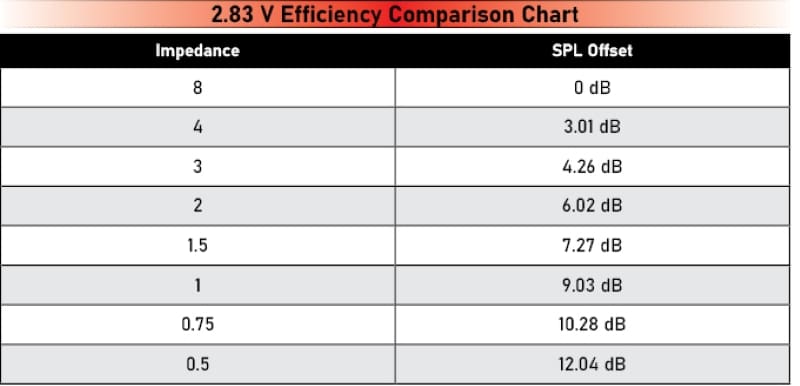
Sound Level and Distance from the Sound Source
Before we examine the benefits and drawbacks of each specification method, we’ll discuss what’s common to both: the 1-meter measuring distance.
If you live in the U.S., it’s worth explaining that 1 meter equals 39.3701 inches, or 3 feet and 3.3701 inches. Using either the 1-watt or 2.83-volt speaker efficiency specification method is equivalent to a microphone or listener 1 meter from the speaker cone. If you are 2 meters away, the amplitude will be 6 dB lower. The sound level will be 6 dB higher if you are at half the distance, 50 centimeters or 19.685 inches. Pay close attention to speaker efficiency specifications; some companies provide 1-watt at 0.5-meter numbers.
Speaker Sensitivity Measurements
Car audio manufacturers use two methods to generate speaker sensitivity specifications. The simplest is to place a microphone 1 meter from the speaker and perform a frequency response sweep at a specific voltage level. This will produce a chart that shows the driver’s output at each measured frequency. However, this doesn’t produce a single efficiency number. That said, the information is much more helpful in determining the suitability of a speaker for different applications. We’ll dive into extracting data from frequency response measurements another time. Most manufacturers will average the output of the above measurement to provide a single efficiency number.
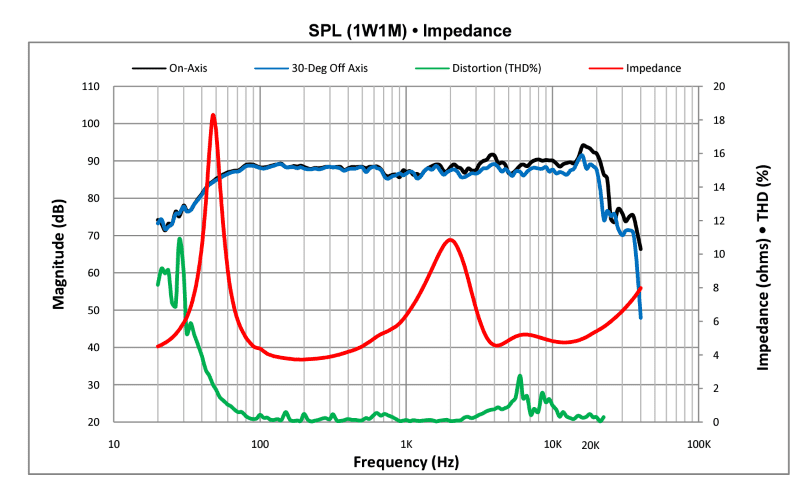
The second method for specifying a speaker’s predicted efficiency is based on a formula using Thiele/Small parameters. The formula calculates the reference or “power available” efficiency, represented by the lowercase Greek letter Eta (H), which looks like an n with a longer right-side tail, and the subscript 0.

As you can see from the above formula, a higher equivalent compliance (Vas) value will increase efficiency. A higher electrical damping factor (Qes) reduces efficiency. Importantly, even a slight increase in the driver’s resonant frequency (Fs) dramatically increases efficiency as the value is cubed.
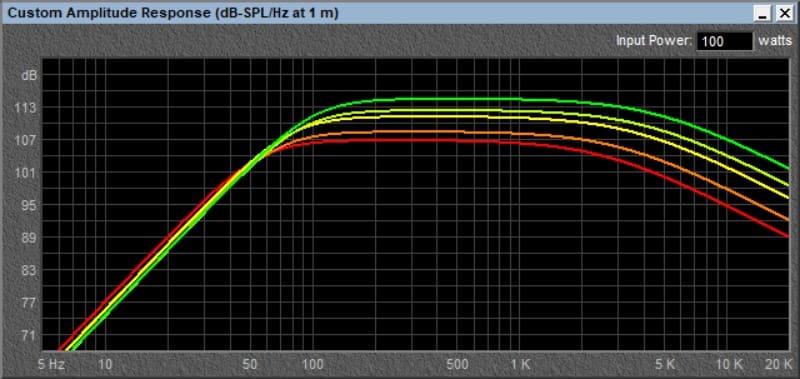
The graph above shows the predicted frequency response of a high-quality 6.5-inch car audio woofer in red. The orange graph is the same driver with a 10 Hz higher resonant frequency and a lighter cone. The yellow trace is the same driver with a 20 hertz higher resonant frequency, and so on. As you can see, the efficiency increases significantly, but the amount of bass the driver produces relative to the midrange decreases.
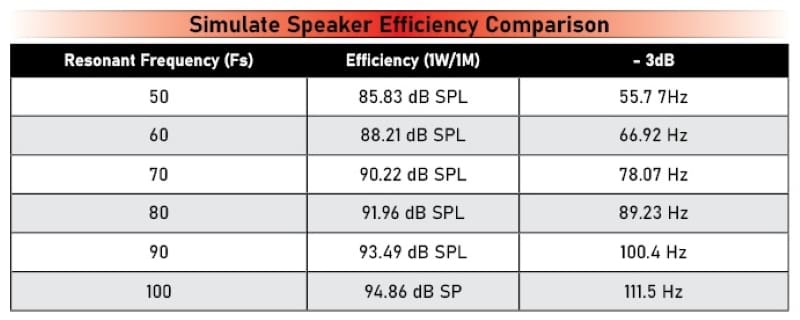
Subwoofers and Efficiency Numbers
It’s absolutely crucial to understand that a subwoofer’s efficiency number doesn’t directly correlate to the amount of bass it will produce. For example, if you cram a 12-inch subwoofer into a 0.85-cubic-foot sealed enclosure, an 8-inch subwoofer in a 0.6-cubic-foot ported enclosure is louder from 25 to 45 hertz with the same power. Comparison of subwoofer efficiency numbers is misleading, so simulation software is required to determine whether it will produce more output.
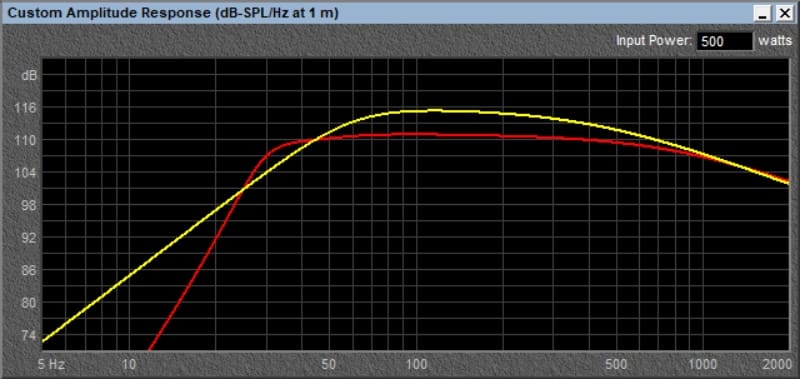
Should We Compare Speaker Efficiency Numbers?
In many cases, comparing the efficiency of similarly sized speakers based on efficiency is more likely to provide information about how little bass they produce than how loudly they can play. If your application doesn’t need much output below 200 hertz, a more efficient speaker is likely a good choice. However, there is a lot of crucial audio information below 200 hertz. Most male voices extend to 100 Hz, with some like Johnny Cash, Leonard Cohen and David Draman of Disturbed being much lower. If you want to hear their voices clearly, you need speakers that play lower frequencies louder.
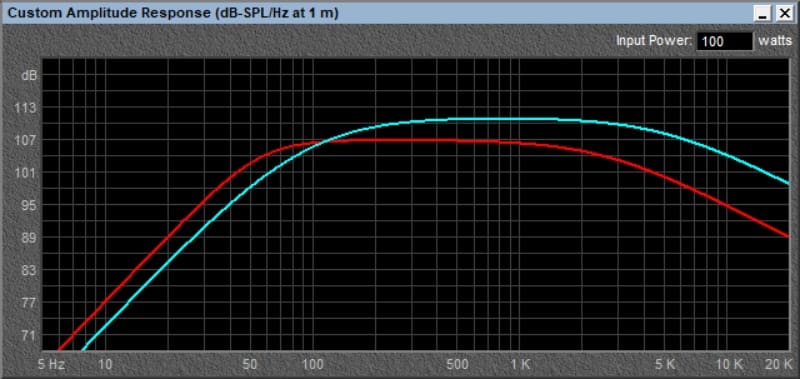
Every specification in a speaker design interacts with all the others to produce a specific end product. When it comes to efficiency, the trade-off is typically bass performance. Shopping for speakers based on their efficiency parameters might not yield the desired results. When it’s time to pick speakers for your car, truck, boat or motorcycle, drop by a local specialty mobile enhancement retailer and talk to them about your expectations for the system. You might find that a driver with a lower efficiency specification sounds much better than one with a higher number.
This article is written and produced by the team at www.BestCarAudio.com. Reproduction or use of any kind is prohibited without the express written permission of 1sixty8 media.
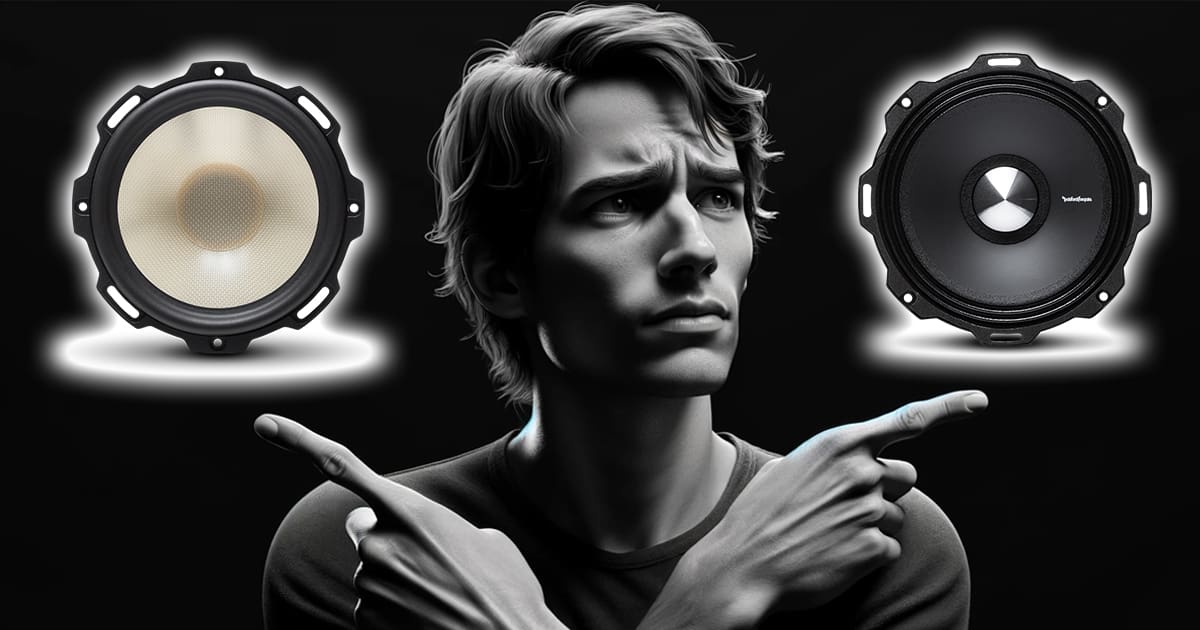

Leave a Reply